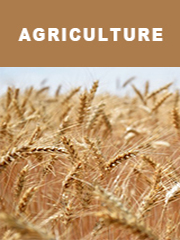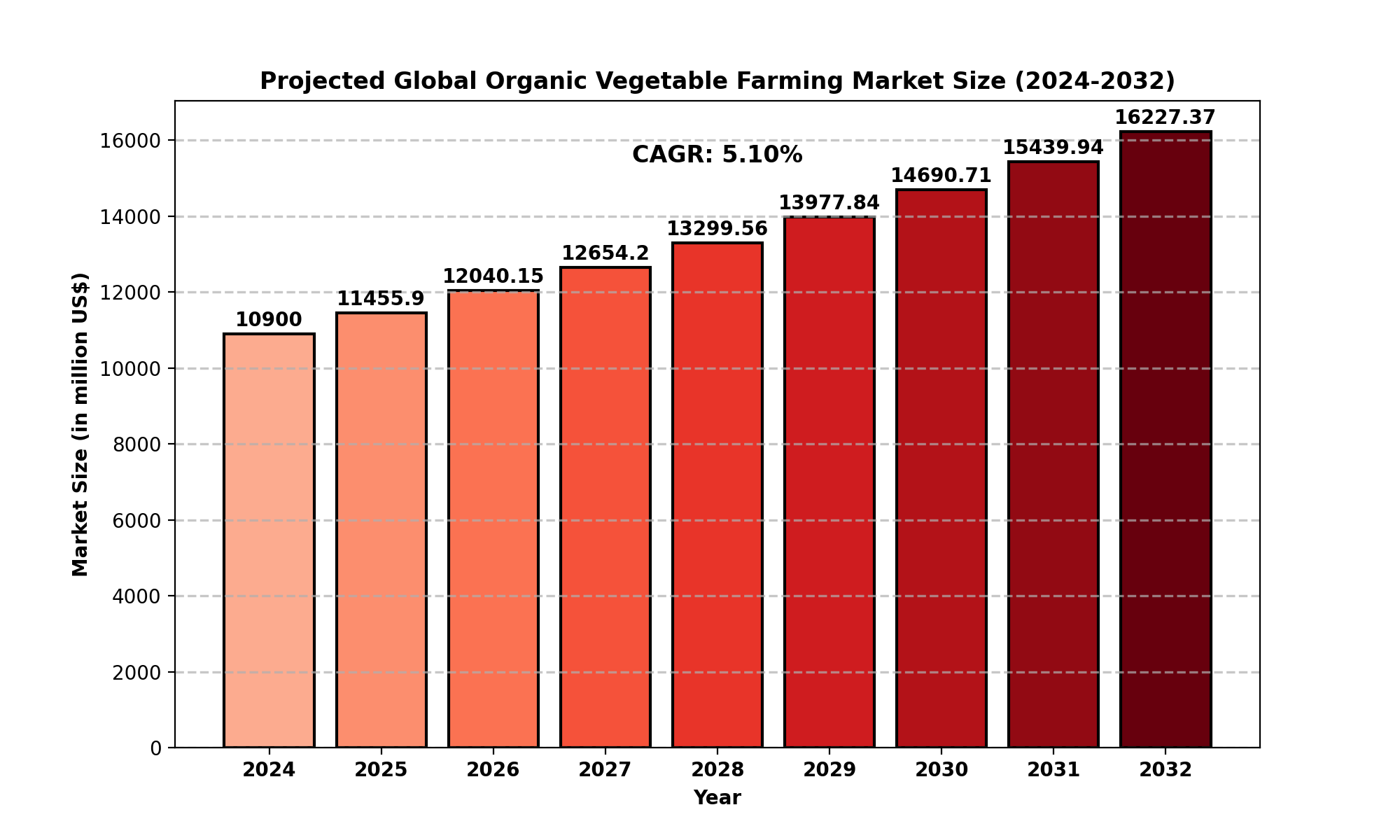TOP CATEGORY: Chemicals & Materials | Life Sciences | Banking & Finance | ICT Media

Download Report PDF Instantly
Report overview
Organic vegetable farming refers to the cultivation of vegetables using organic methods that prioritize environmental sustainability, soil fertility, and biological diversity. This type of farming avoids synthetic chemicals such as pesticides and fertilizers, instead relying on organic inputs like compost, manure, and crop rotation techniques. The practice enhances soil health, promotes biodiversity, and produces vegetables that are free from harmful chemicals, appealing to consumers focused on health and environmental conservation.
Market Size
The global Organic Vegetable Farming market was valued at USD 10,900 million in 2024 and is projected to reach USD 16,227.37 million by 2032, growing at a compound annual growth rate (CAGR) of 5.10% during the forecast period.
North America holds a significant share of the market, with its organic vegetable farming market valued at USD 3,093.97 million in 2024, exhibiting a CAGR of 4.37% from 2024 to 2032.
The consistent growth is fueled by increasing consumer demand for organic produce, advancements in organic farming techniques, and government incentives promoting sustainable agricultural practices.

Market Dynamics (Drivers, Restraints, Opportunities, and Challenges)
Drivers
Rising Consumer Awareness: The increasing awareness regarding the health benefits of organic vegetables is a primary driver. Organic produce is free from synthetic chemicals, aligning with consumer preferences for clean and nutritious food.
Government Initiatives: Policies supporting organic farming, including subsidies, certifications, and training programs, contribute significantly to market growth.
Environmental Sustainability: Organic farming’s focus on preserving soil fertility, reducing pollution, and encouraging biodiversity drives its adoption globally.
Growing Organic Food Market: The expanding global organic food market, which includes vegetables as a key segment, further propels the organic vegetable farming market.
Restraints
High Production Costs: Organic farming often involves higher labor and input costs, which can limit its adoption among small-scale farmers.
Yield Limitations: Compared to conventional farming, organic methods may result in lower yields, which can challenge profitability, particularly in regions with high demand.
Certification Barriers: The complexity and cost of obtaining organic certifications can deter farmers from entering the organic vegetable market.
Opportunities
Emerging Markets: Developing countries present untapped potential as they increasingly embrace organic farming practices.
Technological Advancements: Innovations in organic fertilizers, pest management, and farming techniques offer opportunities to improve efficiency and yields.
Expanding Retail Channels: The growth of organic sections in supermarkets and online grocery platforms creates new avenues for market expansion.
Challenges
Climate Sensitivity: Organic farming is more susceptible to adverse weather conditions, which can impact crop yields.
Market Competition: Competition from conventional vegetable farming, which often provides cheaper alternatives, poses a challenge to the organic market.
Regional Analysis
North America
North America dominates the organic vegetable farming market, with the United States leading in terms of production and consumption. The region’s growth is driven by strong consumer demand, supportive government policies, and well-established organic certification standards.
Europe
Europe is another significant market, with countries like Germany, France, and the UK actively promoting organic farming through subsidies and public awareness campaigns. The region’s stringent regulations on chemical use further boost organic vegetable farming.
Asia-Pacific
The Asia-Pacific region exhibits rapid growth, fueled by increasing health awareness and rising disposable incomes in countries like China, India, and Japan. Governments in these nations are also encouraging organic farming through training programs and financial incentives.
South America
South America is emerging as a promising market due to its vast agricultural land and favorable climatic conditions for organic farming. Brazil and Argentina are key contributors, supported by increasing exports of organic produce.
Middle East and Africa
The Middle East and Africa region shows potential for growth, particularly in high-income countries like the UAE and Saudi Arabia, where consumer interest in organic food is rising. However, challenges such as limited water resources and high production costs may hinder growth.
Competitor Analysis
The organic vegetable farming market is highly competitive, with several key players contributing to its growth. Companies focus on strategies such as product innovation, partnerships, and geographic expansion to strengthen their market positions. Notable players include:
Naturz Organics
Agro Food Picks
Organic Farm
AeroFarms
Plenty Unlimited Inc
BASF
Green Organic Vegetable Inc.
ISCA Technologies
Nature's Path
Orgasatva MycoSolutions
Agrilution Systems GmbH
Terramera
Back to the Roots
Vital Farms
Market Segmentation (by Application)
Farm Planting: Large-scale organic vegetable farms focusing on bulk production for retail and export markets.
Base Plantation: Smaller-scale operations often catering to local markets or specific niches.
Others: Includes urban farming initiatives and experimental projects.
Market Segmentation (by Type)
Pure Organic Farming: Farming methods strictly adhering to organic principles without synthetic inputs.
Integrated Organic Farming: Combines organic practices with modern agricultural techniques for enhanced productivity.
Others: Emerging methods and hybrid approaches.
Key Company
The following companies play a pivotal role in the global Organic Vegetable Farming market:
Naturz Organics
Agro Food Picks
Organic Farm
AeroFarms
Plenty Unlimited Inc
BASF
Green Organic Vegetable Inc.
ISCA Technologies
Nature's Path
Orgasatva MycoSolutions
Agrilution Systems GmbH
Terramera
Back to the Roots
Vital Farms
Geographic Segmentation
North America: USA, Canada, Mexico
Europe: Germany, UK, France, Russia, Italy, Rest of Europe
Asia-Pacific: China, Japan, South Korea, India, Southeast Asia, Rest of Asia-Pacific
South America: Brazil, Argentina, Columbia, Rest of South America
Middle East and Africa: Saudi Arabia, UAE, Egypt, Nigeria, South Africa, Rest of MEA
FAQ Section
What is the current market size of the Organic Vegetable Farming market?
The global Organic Vegetable Farming market was valued at USD 10,900 million in 2024 and is expected to reach USD 17,054.97 million by 2032, growing at a CAGR of 5.10% during the forecast period.
Which are the key companies operating in the Organic Vegetable Farming market?
Key companies include Naturz Organics, Agro Food Picks, AeroFarms, Plenty Unlimited Inc, BASF, and Green Organic Vegetable Inc., among others.
What are the key growth drivers in the Organic Vegetable Farming market?
Key drivers include rising consumer awareness about health and sustainability, government support for organic farming, and the growing demand for chemical-free produce.
Which regions dominate the Organic Vegetable Farming market?
North America and Europe are leading regions, with Asia-Pacific showing rapid growth potential.
What are the emerging trends in the Organic Vegetable Farming market?
Emerging trends include technological advancements in organic farming methods, increasing online retail for organic vegetables, and the expansion of organic farming in developing regions.
Key Benefits of This Market Research:
Industry drivers, restraints, and opportunities covered in the study
Neutral perspective on the market performance
Recent industry trends and developments
Competitive landscape & strategies of key players Potential & niche segments and regions exhibiting promising growth covered
Historical, current, and projected market size, in terms of value
In-depth analysis of the Organic Vegetable Farming
Market Overview of the regional outlook of the Organic Vegetable Farming Market:
Key Reasons to Buy this Report:
Access to date statistics compiled by our researchers. These provide you with historical and forecast data, which is analyzed to tell you why your market is set to change
This enables you to anticipate market changes to remain ahead of your competitors You will be able to copy data from the Excel spreadsheet straight into your marketing plans, business presentations, or other strategic documents
The concise analysis, clear graph, and table format will enable you to pinpoint the information you require quickly
Provision of market value data for each segment and sub-segment Indicates the region and segment that is expected to witness the fastest growth as well as to dominate the
market Analysis by geography highlighting the consumption of the product/service in the region as well as indicating the factors that are affecting the market within each region
Competitive landscape which incorporates the market ranking of the major players, along with new service/product launches, partnerships, business expansions, and acquisitions in the past five years of companies profiled
Extensive company profiles comprising of company overview, company insights, product benchmarking, and SWOT analysis for the major market players The current as well as the future market outlook of the industry
concerning recent developments which involve growth opportunities and drivers as well as challenges and restraints of both emerging as well as developed regions Includes in-depth analysis of the market from various perspectives through Porter’s
five forces analysis Provides insight into the market through Value Chain Market dynamics scenario, along with growth opportunities of the market in the years to come 6-month post-sales analyst support
Customization of the Report In case of any queries or customization requirements, please connect with our sales team, who will ensure that your requirements are met.
Chapter Outline
Chapter 1 mainly introduces the statistical scope of the report, market division standards, and market research methods.
Chapter 2 is an executive summary of different market segments (by region, product type, application, etc), including the market size of each market segment, future development potential, and so on. It offers a high-level view of the current state of the Organic Vegetable Farming Market and its likely evolution in the short to mid-term, and long term.
Chapter 3 makes a detailed analysis of the market's competitive landscape of the market and provides the market share, capacity, output, price, latest development plan, merger, and acquisition information of the main manufacturers in the market.
Chapter 4 is the analysis of the whole market industrial chain, including the upstream and downstream of the industry, as well as Porter's five forces analysis.
Chapter 5 introduces the latest developments of the market, the driving factors and restrictive factors of the market, the challenges and risks faced by manufacturers in the industry, and the analysis of relevant policies in the industry.
Chapter 6 provides the analysis of various market segments according to product types, covering the market size and development potential of each market segment, to help readers find the blue ocean market in different market segments.
Chapter 7 provides the analysis of various market segments according to application, covering the market size and development potential of each market segment, to help readers find the blue ocean market in different downstream markets.
Chapter 8 provides a quantitative analysis of the market size and development potential of each region from the consumer side and its main countries and introduces the market development, future development prospects, market space, and capacity of each country in the world.
Chapter 9 shares the main producing countries of Organic Vegetable Farming, their output value, profit level, regional supply, production capacity layout, etc. from the supply side.
Chapter 10 introduces the basic situation of the main companies in the market in detail, including product sales revenue, sales volume, price, gross profit margin, market share, product introduction, recent development, etc.
Chapter 11 provides a quantitative analysis of the market size and development potential of each region during the forecast period.
Chapter 12 provides a quantitative analysis of the market size and development potential of each market segment during the forecast period.
Chapter 13 is the main points and conclusions of the report.